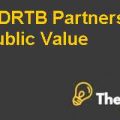Implementing Quantitative Risk Management and VaR in a Chinese Investment Bank Case Study Solution
Part B
With the use of the different look back periods, such as 6 and 9 months at the confidence level of 95 percent; the number of exceptions are calculated for 6 month period and 9 month period for both S&P and Shanghai stock exchange. The exceptions for S&P for 6 and 9 months are 0.84 and 3.25, respectively, which shows that the number of the actual observations exceeds above and over the expected level of return calculated using the Variance-Covariance method. Additionally, the comparison between the exceptions for 6 month and 9 months show that the exceptions have increased over the period of time.
On the other hand, the exceptions for Shanghai 6 and 9 months are 1.47 and 1.47, respectively, which shows that the number of the actual observations exceeds above and over the expected level of return calculated using the Variance-Covariance method. Additionally, the comparison between exceptions for 6 month and 9 months show that the exceptions remained constant over the period of time, thus changing the conclusion that the returns on S&P are lower than the returns on Shanghai stock exchange.
Part C
The back testing truly supports the Value at Risk model due to the fact that one could rely on the Value at Risk model as it passes a back test. Additionally, the back testing tends to give the reality check on whether the forecast of Value at Risk model are accurate and properly calibrated(Cakici, 2004). Not only this, it also provides the Basel Committee with the critical technique of evaluation, to test the adequacy of internal Value at Risk models.(Halilbegovic, 2016).
Part D
Jasper uses the back test results in order to confirm the reliability and accuracy of the validation of the Value at Risk model, which indicates that Jasper needs to make back-test a part of the daily Value at Risk calculations. The results drawn from the back testing would provide him with valuable information and insights regarding whether the potential risk or problem exist in core system of the company or not, thus helping Jasper in taking necessary risk mitigation measures & protecting the organizations from the potential future problem and risks. Furthermore, Jasper could better utilize the Value at Risk model through critically analyzing the adjusted returns for the given level of invested capital.
Based on the data provided, what would be the Conditional VaR (CVaR) in this example? Explain your model and assumptions
The Conditional Value at Risk also referred to the expected shortfall which tends to lead towards more conservative approach in terms of risk exposure. The Conditional Value at Risk attempts to address the shortfalls of the Value at Risk model, and is widely used to measure the financial risk level within the firm. The formula used to calculate the values of CVaR, is as follows:
CVaR = (1/VaR) * Sum of returns of VaR
Whereas;
VaR = (1 – distribution level) * Count of total returns
On the basis of the provided data, on 5 percent distribution level; the company would lose 1.98 value in the single day.Whereas Value at Risk 95 is positive in S&P and negative in Shanghai to 2.18 and -1.98 percent, which means there is 5 percent chance that the company would lose 1.98 percent or more in the single day. The assumptions of the Conditional Value at Risk model are as follows:
- The Conditional Value at Risk provides average lost value in the worst case scenario.
- C-VaR values shows worse potential losses as compared to the corresponding values of VaR because VaR in essence, ignoring the worst possible returns or the fat tails of the distribution of historical returns.
- The Conditional Value at Risk takes the weighted average of VaR.
Conclusion
Jasper Wang was concerned about how he would push more quantitative risk & control framework in the face of the domain issues, dismissal of measures of risk management used outside of China as well as the basic differences in the culture about how the things are done within the domestic organization. He made Value at Risk (VaR) the first step of rationalizing the function of trading, because the staff and the traders didn’t stress over the significance of formal risk management system, and Jianguo Lu also opposed the idea presented by Jasper by stating that no formal risk management system could replace his years of experience and expertise in the Chinese market.
The returns on S&P are greater than the returns on Shanghai stock exchange. Jasper is required to witness how his plan would theoretically perform and could gauge the efficiency of the trading strategy. The back testing truly supports the Value at Risk model, due to the fact that one could rely on the Value at Risk model as it passes a back test. Additionally, the back testing tends to give the reality check on whether the forecast of Value at Risk model are accurate and properly calibrated.Jasper used the back test results in order to confirm the reliability and accuracy of the validation of the Value at Risk model, which indicates that Jasper needs to make back-test a part of the daily Value at Risk calculations..........
This is just a sample partial case solution. Please place the order on the website to order your own originally done case solution.










